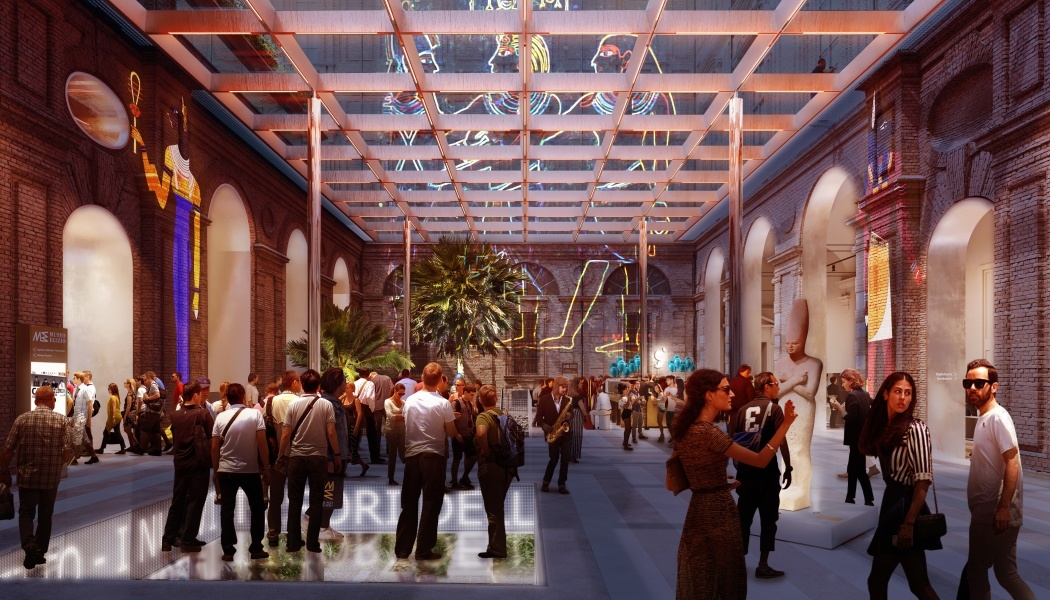On January 26, 2023, architect OMA / David Gianotten and Andreas Karavanas won the competition to repurpose, renew and transform the historic Museo Egizio in Turin (Torino), Italy, reconnecting it to the neighborhood in the process. This reflects the reliable 3Re Strategy for revitalization (repurpose, renew, reconnect), that was first documented in the 2020 book, RECONOMICS: The Path To Resilient Prosperity.
Built in 1824, Museo Egizio is the world’s oldest museum for Ancient Egyptian culture. The redesign creates a new covered courtyard known as Piazza Egizia, and a series of connected urban rooms within the existing museum, opening the cultural space to all.
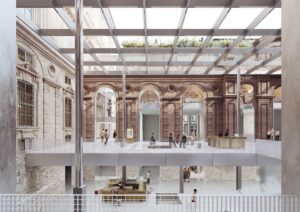 Museo Egizio founded in 1824 is housed in Collegio dei Nobili – a complex consisting of exhibition galleries, the Academy of Sciences, and an open courtyard. Changing requirements over the past two centuries have led to numerous alterations to the museum’s architecture, closing the public areas off to the rest of the city.
Museo Egizio founded in 1824 is housed in Collegio dei Nobili – a complex consisting of exhibition galleries, the Academy of Sciences, and an open courtyard. Changing requirements over the past two centuries have led to numerous alterations to the museum’s architecture, closing the public areas off to the rest of the city.
OMA’s Managing Partner, architect David Gianotten, says “Museo Egizio, with an open courtyard, is historically a main civic space in Turin. Our team believes that it is vital to restore the public nature of the museum and integrate it back with Turin’s network of public spaces. By reorganizing the current museum’s public areas, we have created the Piazza Egizia, which is a place for all kinds of activities shared between Museo Egizio and the city.”
The redesign is defined by six distinctive urban rooms, each with its unique scale, function, and quality. The largest urban room central to the museum is the Piazza Egizia. A central Spine connects the six urban rooms together, and also to both of the museum’s entrances on Via Accademia and Via Duse.
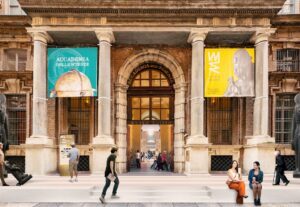 New openings have been introduced to the current façade along Via Duse, further drawing the public into the museum and the Piazza Egizia. The six urban rooms share a ground floor pattern – inspired by the museum’s artefacts – for visual continuity.
New openings have been introduced to the current façade along Via Duse, further drawing the public into the museum and the Piazza Egizia. The six urban rooms share a ground floor pattern – inspired by the museum’s artefacts – for visual continuity.
The Piazza Egizia is a double-level, multifunctional courtyard that showcases the museum’s original architecture and traces of interventions over time. The multiple historic openings of the courtyard at level 0 – which had been closed due to the museum’s alterations – are once again opened, connecting the public space back to the city.
At level -1 are the Egyptian Garden and the event and learning space. Here, Collegio dei Nobili’s original façade concealed since the 2010 renovation is uncovered.
Above the courtyard is a transparent canopy. Its aluminum cladded steel structural grid is a device for rainwater collection, air ventilation, and lighting provision, answering the museum’s ambitions for sustainability.
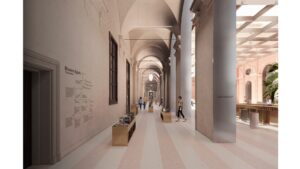 OMA Project Architect Andreas Karavanas: “We have conceptualized the Piazza Egizia as a palimpsest that reveals the different layers of the museum’s history. This approach restores coherence to the architecture and lends the museum a lucid identity, while ensuring that the institution’s new needs are fulfilled.”
OMA Project Architect Andreas Karavanas: “We have conceptualized the Piazza Egizia as a palimpsest that reveals the different layers of the museum’s history. This approach restores coherence to the architecture and lends the museum a lucid identity, while ensuring that the institution’s new needs are fulfilled.”
The Piazza Egizia and other urban rooms are open beyond working hours for visitors with or without tickets. Their public nature offers possibilities for the museum to extend its opening hours. A selection of Museo Egizio’s artefacts is on display for the general public’s initial encounters with the museum collection.
Museum Egizio is housed in Collegio dei Nobili. A complex consisting of exhibition galleries, the Academy of Sciences, and an open courtyard, the museum’s architecture has undergone numerous alterations in the past two centuries, increasingly becoming enclosed and detached from the rest of the city.
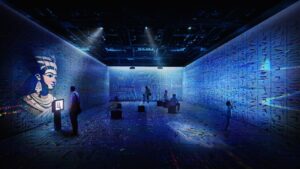 Museo Egizio 2024 addresses the museum’s historic role as a main civic space in Turin and its 21st century social ambitions. The design creates a new, covered courtyard known as Piazza Egizia and a series of connected urban rooms open to all, integrating the museum back with Turin’s network of public spaces, while instilling it with a lucid identity.
Museo Egizio 2024 addresses the museum’s historic role as a main civic space in Turin and its 21st century social ambitions. The design creates a new, covered courtyard known as Piazza Egizia and a series of connected urban rooms open to all, integrating the museum back with Turin’s network of public spaces, while instilling it with a lucid identity.
The project reorganizes the museum’s public areas into six distinctive urban rooms, each with its unique scale, function, and quality. The largest urban room central to the museum is the Piazza Egizia, designed as a public space shared between Museo Egizio and the city. A central Spine connects the six urban rooms together, also to both of the museum’s entrances on Via Accademia and Via Duse.
Openings have been introduced to the current building façade on Via Duse, inviting the public into the museum and Piazza Egizia for various daily leisure activities. A geometric ground floor pattern – inspired by the museum’s artefacts such as the Merit’s funerary mask – creates visual continuity across the urban rooms.
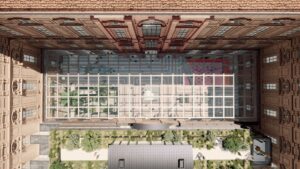 The Piazza Egizia is a double-level, multifunctional courtyard conceived as a palimpsest of Museum Egizio’s history. Here, the original architecture and traces of interventions over time are showcased. At level 0, the multiple historic openings of the courtyard – which had been closed since the museum’s 2010 renovation – have been restored, connecting this public space back to the city.
The Piazza Egizia is a double-level, multifunctional courtyard conceived as a palimpsest of Museum Egizio’s history. Here, the original architecture and traces of interventions over time are showcased. At level 0, the multiple historic openings of the courtyard – which had been closed since the museum’s 2010 renovation – have been restored, connecting this public space back to the city.
At level -1 where the Egyptian Garden and the event and learning space are located, Collegio dei Nobili’s original façade – also concealed since the 2010s – is uncovered. Two ground openings at level 0 – directly above the Egyptian Garden and the event and learning space – bring light and direct visitors to the underground.
A transparent canopy, supported by extensions of existing columns, is installed above the Piazza Egizia to create a tempered environment. The canopy’s aluminium cladded steelstructural grid – defined by the regular rhythm of Collegio dei Nobili’s façade – is in itself a device for rainwater collection, air ventilation, and lighting provision, answering to the museum’s ambitions for sustainability.
The Piazza Egizia and other urban rooms are open beyond working hours and welcome all visitors, with or without tickets. Their public nature offers possibilities for the museum to extend its opening hours.
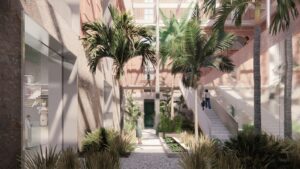 A selection of Museo Egizio’s artefacts is on display for the general public’s initial encounters with the museum collection.
A selection of Museo Egizio’s artefacts is on display for the general public’s initial encounters with the museum collection.
From the urban rooms, visitors go on to see the museum exhibitions, or stay for free leisure activities and events, or continue strolling into other civic spaces in Turin. Museo Egizio 2024 is a destination for scholars and an interested public, and a rediscovered public place for all.
The competition design was led by OMA’s David Gianotten and Andreas Karavanas, in collaboration with local architects Andrea Tabocchini Architecture, T-Studio, and historical consultant Professor Andrea Longhi.
OMA’s design was selected among competition entries by Kengo Kuma and Associates, Pininfarina Architecture, Carlo Ratti Associati, and Snøhetta.
Images courtesy of OMA.

